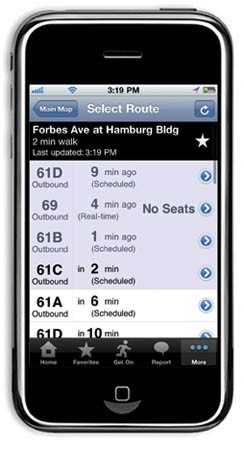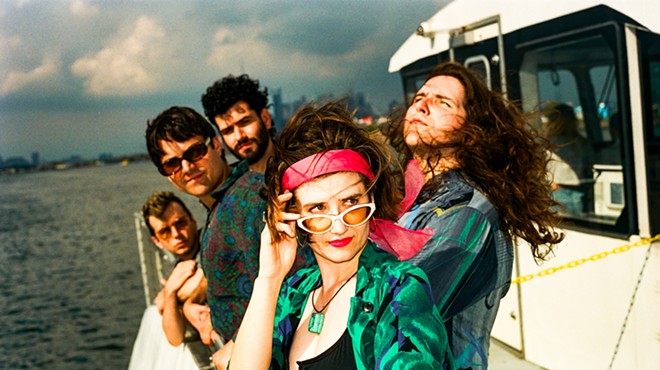After years of budget deficits and route cuts, riders using Port Authority buses and light rail are accustomed to facing uncertainty. The last year alone brought layoffs, route eliminations and a question about where future funding will come from for the Allegheny County transit agency.
With so many questions swirling around, riders now can at least get answers to two of them -- "Where's my bus?" and "Can I get on it?" -- courtesy of a new smart-phone application from Carnegie Mellon University.
The free app, called Tiramisu (Italian for "pick me up"), uses crowdsourcing -- a method by which information is gathered from users, rather than stemming from a central source -- to report the real-time location, estimated arrival time and capacity of oncoming Port Authority buses and light-rail vehicles.
"This is a great [opportunity] to provide services to the city but also really explore where you can go with this kind of experience," says Aaron Steinfeld, a senior systems scientist at the CMU Robotics Institute and co-designer of Tiramisu.
The app is currently available on the iPhone, and will be available on the Android system "in a matter of weeks," says Steinfeld. Developers initially chose the iPhone because its voice-over features are useful for individuals who are visually impaired.
When a rider boards a bus, Tiramisu's interface allows him or her to report its location and fullness, from "many seats," "few seats," "no seats" to "full." Meanwhile, riders at a bus stop can choose their location on a map, and then see the oncoming buses, their capacity and estimated time of arrival (ETA). When real-time rider data isn't available, the system will rely on historical data based on Port Authority schedules and previously collected information.
During a July 27 demonstration at CMU, five of the six buses City Paper tracked were within one minute of their ETA predicted by the app. "One minute is better than what it should be" according to the PAT schedule, noted CMU systems scientist Anthony Tomasic, who developed Tiramisu with Steinfeld and associate professor John Zimmerman.
PAT's on-time performance -- arriving no later than five minutes past the scheduled time -- was 84.32 percent in June. Vehicles arriving early are not considered on time.
A project of the Rehabilitation Engineering Research Center on Accessible Public Transportation (RERC-APT) at CMU and the University of Buffalo, the app is based on universal design -- meaning designs are accessible to people with and without disabilities. In the case of Tiramisu, Steinfeld says the goal was to make transit more accessible. "It's useful to everyone, but it's critical if you need to find a seat."
Riders with disabilities "learn to ride the system and how to use it," says John Tague, a transit advocate and member of the Committee for Accessible Transportation. Tague, who uses a wheelchair, frequently rides the 61C and 61D. But when the students return to Oakland during the school year, those buses often become too crowded, and Tague uses a different bus. "In general, there are less buses out there now," he says. "There are some places [where] it's difficult to get on."
The Port Authority tries to accommodate riders with disabilities. For example, its safety-net program is meant to prevent riders from being passed up. If there's a circumstance that would prohibit a rider from boarding -- such as a broken wheelchair lift or if the bus is at full capacity -- the operator is supposed to radio PAT's traffic division and report it, as well as find out when the next bus is coming.
If it's more than 30 minutes until the next bus, the traffic division will arrange for that rider to be picked up. During the first six months of the calendar year, Port Authority operators radioed in 27 pass-ups of riders in wheelchairs, according to Heather Pharo, PAT's social-media and communications specialist
Tiramisu also has a feature that allows riders to report both problems and positive experiences via text or photo that will be fed back to the Port Authority. CMU and PAT are still working out how the data exchange will work, but PAT says it welcomes the information.
"Part of this data is to help us as well as help the riders out," Pharo says.
Most buses are equipped with a GPS-based device that enunciates the stops as the bus approaches them. But, as Pharo notes, "we're missing the technology that would take that information and transmit it in real time and turn it into something usable for riders."
"The reality is if you want this kind of system, it's going to cost tens of millions of dollars," Steinfeld says. "Pittsburgh just can't do that."
That's where the RERC-APT comes in, which was supported in part by CMU's Traffic21 Initiative, to develop technology advancements for the area's transportation system.
Pharo notes that having the information available via CMU's smart-phone app is another way -- in addition to the agency's presence on Twitter and development of a mobile-phone friendly website -- to free up its customer-service line. On a typical day, Pharo says, customer service receives slightly more than 3,000 phone calls.
"We're in favor of anything that can give riders more information that can potentially improve their experience. Improved experiences on transit have the ability to potentially boost ridership," Pharo says. "We have limited resources here."















